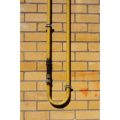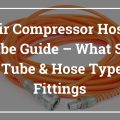Hey! This site is reader-supported and we earn commissions if you purchase products from retailers after clicking on a link from our site.
When selecting fittings for your compressed air system, people ponder whether they should get steel or brass air fittings. This article will provide you with all the relevant information on both, and set out the differences!
Table of Contents
- What Are Air Fittings?
- What Are Steel Air Fittings?
- What Are Brass Air Fittings?
- Steel vs Brass Air Fittings – Which Is Better?
- FAQs (Frequently Asked Questions)
What Are Air Fittings?
Pneumatic fittings provide an ever-so-essential link between tubes, hoses, and other components in pneumatic systems. Air fittings typically have tighter seals and lower pressure requirements compared to hydraulic fittings and are available in various connector types.
Not only do air fittings connect pneumatic components and stop the flow of unused ports, but they can also be used to control directional flow and airflow pressure. These fittings are available in different styles such as:
- Thread to barb fittings
- Threaded fittings
- Barb to barb fittings
- Push-in fittings
- Metric fittings
What Are Steel Air Fittings?
Steel, or stainless steel, fittings are designed to be used with high pressures, vacuums, and consistent vibration in order to deliver leak-proof joints. This makes steel fittings suitable for almost any environment, particularly pneumatic and hydraulic applications.
Due to their great strength and corrosion-resistant properties, steel fittings are well-suited to water hammer and vibration applications, whilst delivering excellent sealing and retention of the pipes.
Here’s an example of a 9-piece air compressor hose fitting set made from steel.
- 3/8 High Flow Body Size: 3/8 Inch body size air fittings provide up to 70% more air flow than 1/4 Inch body air fittings, 1/4 Inch body air fittings provide 35 SCFM at 100PSI working pressure.
Prices pulled from the Amazon Product Advertising API on:
Product prices and availability are accurate as of the date/time indicated and are subject to change. Any price and availability information displayed on [relevant Amazon Site(s), as applicable] at the time of purchase will apply to the purchase of this product.
What Are Brass Air Fittings?
Brass fittings are suitable for a range of applications within pneumatics and medium-pressure hydraulics. They are particularly compatible with various industrial fluids and boast great corrosion resistance.
Brass is a copper alloy made with Zinc, and the addition of Zinc allows the corrosion resistance, strength, and hardness to be greater. Brass fittings are also resistant to high pressures due to their high tensile strength.
Here’s an example of a 30-piece Brass air fittings set readily available on Amazon.
- ➤ Durable Solid Brass Construction: Made of brass, long-lasting and resistant to corrosion.
Prices pulled from the Amazon Product Advertising API on:
Product prices and availability are accurate as of the date/time indicated and are subject to change. Any price and availability information displayed on [relevant Amazon Site(s), as applicable] at the time of purchase will apply to the purchase of this product.
Steel vs Brass Air Fittings – Which Is Better?
Both steel and brass air fittings have their own benefits. A major benefit that brass fittings hold over steel fittings is that they boast significantly great corrosion resistance. In addition to this, in terms of thermal and electrical conductivity, brass outweighs stainless steel by up to 15 times.
Brass fittings are perfect for applications that involve extremely high temperatures as they have a significantly higher thermal expansion coefficient. Stainless steel is more suitable for applications that require fluid control of petroleum and high acidic liquids.
Therefore, in terms of pneumatic applications, brass is the better fittings. However, it is important that you use steel fittings for steel piping as brass fittings are not recommended on steel tubing. Brass is softer than steel and may not seal onto the tubing as well as steel fittings, so, this may result in air leaks.
It’s possible galvanic corrosion will occur, which is a process where the corrosion is accelerated by 2 dissimilar metals in contact with one another. If you have copper tubing, then this is the ideal time to use brass fittings.
Brass as a material is typically more expensive than steel. But, it is likely that your brass fittings will seal a lot better than steel
It’s possible to purchase kits that combine brass and steel fittings like the one below on Amazon!
- UNIVERSAL QUICK COUPLER - The 1/4 NPT universal couplers (male and female) which fit Industrial (I/M), ARO (A) and Automotive (T) so you do not worry about whether it is fitting or not. Heavy duty steel air fittings are ideal for general purpose applications and the brass has good solid and durability.
Prices pulled from the Amazon Product Advertising API on:
Product prices and availability are accurate as of the date/time indicated and are subject to change. Any price and availability information displayed on [relevant Amazon Site(s), as applicable] at the time of purchase will apply to the purchase of this product.
This YouTube video below provided by Gregg Distributors LP is a great ultimate guide, covering all aspects of fittings including the materials.
FAQs (Frequently Asked Questions)
Yes, a lot of people tend to use both types of air fittings in their compressed air systems. But only certain types of stainless steel and brass can be used together. If the wrong types are used together, the system will experience galvanic corrosion. And so, you should try to use steel fittings with steel piping and brass fittings with copper piping only, to avoid this risk.
Yes, brass fittings are extremely suitable for compressed air systems as they boast great corrosion resistance and are also resistant to high pressures due to their high tensile strength. It is advised that brass fittings only be used on copper piping and not steel piping, as the coming together of steel and brass may accelerate corrosion.
Additional Reading:
- Using Aluminum Air Pipe For Compressed Air
- Copper Pipe For Compressed Air
- Galvanized vs Black Pipe For Air, Gas And Water
- Using ABS Pipe For Compressed Air
- Using Nylon Tubing For Compressed Air
- PVC Air Lines
- Using Pex Pipe for Compressed Air Lines – Do’s & Don’ts
- Best Compressed Air Pipeline Materials For Compressed Air Piping Systems
- Industrial vs Automotive Air Fittings
- Compressed Air Metric Fittings
- Air Hose Fittings Types – Guide To Air Compressor Coupler Types
- Compressed Air Fittings Guide
- Air Compressor Hose & Tube Guide
- Using Pex-Al-Pex Compressed Air & Pex-Al-Pex Fittings
- Pex A vs Pex B Pipe & Fittings
- PEX Fitting Types Guide
- How to Plumb an Air Compressor Setup in Garage
If you have any questions regarding steel vs brass air fittings, please leave a comment below, with a photo if applicable, so that someone can help you!








